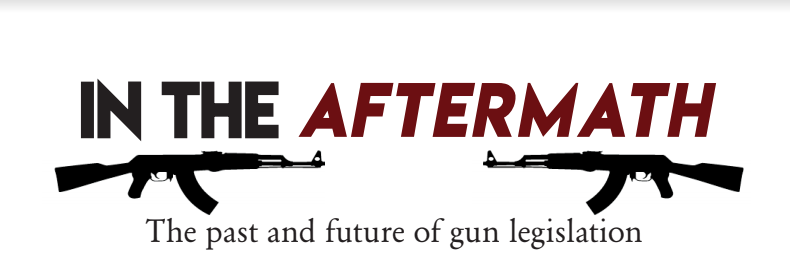April 7, 2018
The aftermath of every shooting is the same. Initial shock leads to conflict over gun legislation, followed by the inevitable politician shutting down the conversation. Then the public silently accepts it and moves on as another story rolls around.
But when the students at Marjory Stoneman Douglas (MSD) High School refused to back down following the mass shooting on Valentine’s Day, a massive partisan debate developed over the best possible way to address and prevent these shootings from taking place. The debate rapidly turned from discussion to insult: Maine Republican House candidate Leslie Gibson recently referred to MSD shooting survivor Emma González as a “skinhead lesbian.”
It’s still important to look closer at what the options are in terms of legislation to slow down, or altogether stop, these mass shootings with everything on the table, from locking schools down like prisons to banning the weapons used in these mass shootings. Many are opposed to the ban of weapons, pointing to its unconstitutionality. However, from 1994 to 2004 the Public Safety and Recreational Firearms Use Protection Act, better known as the “Federal Assault Weapons Ban,” forbade the sale and production in the United States of weapons such as the AR-15.
The law’s history dates back to 1989, when a gunman opened fire on the schoolyard of Cleveland Elementary School in Stockton, California. He fired 106 rounds in three minutes. 34 were wounded and five children were killed. This led to the passing of the Roberti-Roos Assault Weapons Control Act of 1989 in California, which made it illegal to own or transfer over 50 different types of semi-automatic rifles, shotguns and pistols within the state. After no action on a national level, another two shootings followed.
This time, however, Senator Dianne Feinstein (D-CA) authored the Federal Assault Weapons Ban in response to the then three major mass shootings in four years. After passing the Senate in 1993, the bill faced considerable pushback in the House.
In 1994, former U.S. Presidents Gerald Ford, Jimmy Carter, and Ronald Reagan wrote a joint statement to the House in support of the Assault Weapons Ban, citing a CNN/USA Today/Gallup poll from 1993 which showed that 77% of Americans supported the ban of the manufacture, sale and possession of assault weapons, saying that “this is a matter of vital importance to the public safety. While we recognize that assault weapon legislation will not stop all assault weapon crime, statistics prove that we can dry up the supply of these guns, making them less accessible to criminals. We urge you to listen to the American public and to the law enforcement community and support a ban on the further manufacture of these weapons.” The co-signing from the three former presidents greatly helped the push for the bill, and in 1994 it became law as a part of the Violent Crime Control and Prevention Act of 1994.
Since the ban was abandoned in 2004, gun violence experts have seen a large increase in the number of mass shootings in the United States. Louis Klarevas from the University of Massachusetts at Boston reviewed the data from the gun massacres during the past 50 years in the United States. Klarevas’s findings showed that while comparing the 10-year period, the ban was enforced to the 10 years leading up to it, there was a 37% decrease in the number of gun massacres and a 43% decrease in the number of people who died in these massacres. However, when the ban ended in 2004, Klarevas’s findings show a 183% increase in the number of gun massacres and a 239% increase in the number of deaths in gun massacres.
The law banned the manufacture of certain semi-automatic pistols, rifles and shotguns that were deemed “assault weapons” along with magazines deemed “large capacity” for civilian use. But what exactly qualifies as an assault weapon?
There’s actually a legal distinction between an assault weapon and an assault rifle. An assault rifle is, at a basic level, a military-use rifle capable of toggling between semi-automatic and fully-automatic firing. Fully-automatic assault rifles have been banned from production in the United States since 1986, making them now both extremely expensive and rare, and in order to attain one, there are extensive background checks. An assault weapon (although the definition fluctuates from place to place) usually applies to semi-automatic rifles with detachable magazines and a pistol grip.
For a semi-automatic weapon to be placed under the ban, it had to possess a few key characteristics. These banned assault weapons include semi-automatic pistols with detachable magazines, along with two or more military-style features such as a magazine that extended beyond the barrel, a semi-automatic version of a fully-automatic pistol, or a pistol grip. This included the AR-15, the weapon used in Parkland.
